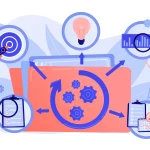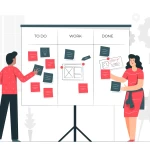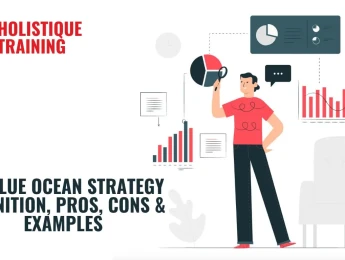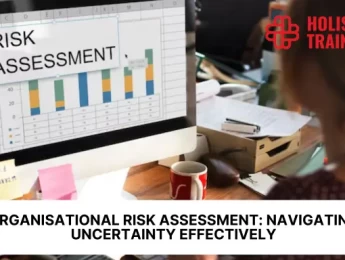- Table of Contents
- What Is Kanban?
- The History of Kanban
- What Is Agile Project Management?
- What Are Kanban Boards in Project Management?
- The Benefits of Using Kanban Agile Methodology
- Flexibility
- Improved Flow
- Enhanced Collaboration
- Waste Reduction
- Predictability
- The 4 Principles of Kanban
- 1- Start with What You Do Now
- 2- Agree to Pursue Incremental, Evolutionary Change
- 3- Respect the Current Process, Roles & Responsibilities
- 4- Encourage Acts of Leadership at All Levels
- 6 Main Practices of Kanban
- 1- Visualise Work
- 2- Limit Work-in-Progress (WIP)
- 3- Manage Flow
- 4- Make Process Policies Explicit
- 5- Implement Feedback Loops
- 6- Improve Collaboratively, Evolve Experimentally
- Kanban vs. Scrum: Which Is Better?
- The Future of Kanban: Emerging Trends and Innovations
- Integration of Artificial Intelligence (AI) and Machine Learning (ML)
- Enhanced Data Analytics and Visualisation
- Greater Integration with DevOps Practices
- Expansion of Kanban Beyond IT
- Evolution of Kanban Metrics
- Conclusion
Introduction
In the world of project management, agility and adaptability are key to success. One methodology that has gained significant attention and popularity is the Kanban Agile Methodology. Combining the principles of Kanban and Agile, this approach offers a unique way to streamline workflows, increase efficiency, and foster collaboration within teams. In this comprehensive guide, we'll delve deep into the world of Kanban Agile, exploring its history, core principles, practices, and benefits, while also comparing it with another widely used methodology, Scrum.
What Is Kanban?
At its core, Kanban is a visual management system that enables teams to improve their workflow processes by visualising tasks, limiting work-in-progress (WIP), and continuously optimising their performance. Originating from Toyota's lean manufacturing system, the Kanban method was introduced by Taiichi Ohno in the 1940s as a way to enhance production efficiency and reduce waste in manufacturing. Its principles were later adapted and extended to other industries, including software development and project management.
The History of Kanban
Kanban's roots trace back to Japan's post-World War II manufacturing industry. Toyota, known for its innovative production processes, pioneered the concept of "just-in-time" manufacturing. The company aimed to produce only what was needed, when it was needed, in order to minimise waste and enhance productivity. Taiichi Ohno, an engineer at Toyota, introduced the Kanban system as a visual tool to signal when and what to produce, ensuring optimal inventory levels and resource allocation.
What Is Agile Project Management?
Before delving into the specifics of Kanban Agile, it's important to understand the foundation on which it stands: Agile project management. Agile is an iterative and collaborative approach to project management that emphasises flexibility, customer collaboration, and the delivery of incremental value. Agile methodologies are designed to respond to changing requirements and market demands, allowing teams to adjust their strategies and priorities as needed.
What Are Kanban Boards in Project Management?
At the heart of the Kanban methodology is the Kanban board, a visual representation of the workflow. Kanban boards are typically divided into columns that represent different stages of work, such as "To Do," "In Progress," and "Done." Tasks are represented as cards that move across the columns as they progress through the workflow. This visual representation provides a clear overview of the team's current workload and the status of each task. Here’s an example of a Kanban board on Trello:
The Benefits of Using Kanban Agile Methodology
According to a survey carried out by Kanban University, Kanbanize, and SwiftKanban, 76% of participants indicated that Kanban demonstrates higher effectiveness compared to alternative methods, with a significant proportion stating it is much more efficient. Here’s why:
Flexibility
One of the standout features of Kanban Agile is its innate adaptability. Unlike rigid project management methodologies, Kanban allows teams to respond quickly and seamlessly to changes in requirements, market conditions, or customer needs. This flexibility is crucial in today's fast-paced business environment, where unpredictability is the norm. Teams employing Kanban can pivot effortlessly, ensuring they consistently deliver value with greater accuracy. This adaptability is especially beneficial in industries with evolving project scopes or dynamic market landscapes.
Improved Flow
Kanban's emphasis on visualising the workflow and limiting work-in-progress leads to a significant improvement in the flow of tasks. The Kanban board, with its clear representation of different work stages, enables team members to monitor progress in real-time. By identifying and addressing bottlenecks promptly, teams experience faster cycle times and reduced wait times. The streamlined flow of work contributes to heightened productivity and efficient task completion, ultimately enhancing the overall project performance.
Enhanced Collaboration
Kanban boards serve as a focal point for promoting transparency and open communication within teams. Every team member can easily track the progress of tasks, making it simpler to identify areas where assistance or collaboration is needed. The visual nature of Kanban boards fosters a shared understanding of the workflow, breaking down silos and encouraging collaborative problem-solving. Enhanced collaboration not only accelerates project timelines but also creates a more cohesive and engaged team dynamic.
Waste Reduction
Inspired by lean manufacturing principles, Kanban places a strong emphasis on the elimination of waste. This includes overproduction, unnecessary delays, and task switching. By visualising the workflow and setting work-in-progress limits, teams can identify and rectify inefficient practices. The result is optimised processes and resource utilisation, leading to a leaner, more efficient project lifecycle. Reduced waste not only contributes to cost savings but also ensures that every effort is directed towards delivering real value to the end-user.
Predictability
Kanban provides a solid foundation for predictability in project management. By leveraging historical data and analytics, teams can make more accurate forecasts and estimations about their work cycles and delivery times. This predictive capability is invaluable for project planning and stakeholder management. The ability to foresee potential challenges and opportunities enables teams to proactively address issues, ensuring a smoother project execution.
In summary, the benefits of adopting the Kanban Agile methodology are multi-faceted, ranging from increased flexibility and improved flow to enhanced collaboration, waste reduction, and predictability. As organisations seek methodologies that can adapt to the complexities of modern project management, Kanban Agile stands as a robust solution, driving success and innovation in an ever-changing landscape.
The 4 Principles of Kanban
Kanban, as a visual management system, operates on four foundational principles that serve as guiding tenets for its implementation. These principles, established to foster continuous improvement and adaptability, are key to understanding the essence of Kanban methodology:
1- Start with What You Do Now
The first principle of Kanban is rooted in pragmatism. It encourages teams to embark on their Kanban journey by acknowledging and leveraging their existing workflow, roles, and processes. Unlike methodologies that demand a radical overhaul, Kanban builds on the current state of operations. This principle recognises that organisations have unique processes that may already be effective in certain aspects. Starting with what is currently in place provides a smooth transition into Kanban, minimising resistance to change and facilitating a more organic integration.
This principle aligns with the philosophy of gradual and sustainable change, emphasising that significant improvements can be achieved by enhancing existing practices rather than discarding them entirely. It enables organisations to leverage their strengths and gradually introduce Kanban's practices, ensuring a more seamless and less disruptive implementation.
2- Agree to Pursue Incremental, Evolutionary Change
Kanban advocates for a mindset of continuous improvement over time. This principle acknowledges that significant and lasting changes are best achieved through incremental steps. Instead of attempting radical transformations, teams are encouraged to pursue small, manageable improvements regularly. This evolutionary approach aligns with the Agile philosophy of embracing change and adapting to evolving requirements.
Incremental changes are not only easier to implement but also less disruptive to ongoing operations. This principle fosters a culture of steady progress, where teams are empowered to experiment with improvements, evaluate their impact, and iterate based on the results. It creates a dynamic and responsive environment where adaptability becomes a natural part of the team's workflow.
3- Respect the Current Process, Roles & Responsibilities
Valuing the expertise and roles of team members is a fundamental aspect of Kanban. This principle recognises that organisational change can be challenging, and teams often possess valuable knowledge and skills that should be preserved. Kanban encourages a respectful approach to change by working with, rather than against, the existing process, roles, and responsibilities.
By respecting the current state, Kanban ensures that individuals are not alienated or overwhelmed by sudden alterations to their roles or processes. Instead, it seeks to empower teams by acknowledging their skills and experience. This principle aligns with the idea that sustainable change involves collaboration and understanding the unique contributions of each team member. It fosters a sense of ownership and engagement, crucial for the successful adoption of Kanban.
4- Encourage Acts of Leadership at All Levels
Leadership in Kanban is not confined to managerial roles. This principle recognises that every team member has the potential to contribute ideas, suggest improvements, and take ownership of their work. By fostering a culture of shared leadership, Kanban encourages active participation and engagement from everyone involved in the workflow.
This principle aligns with the principles of servant leadership, emphasising that leaders should facilitate the success of their teams rather than command and control. In a Kanban environment, acts of leadership can come from any team member who identifies a way to enhance the process, improve efficiency, or address challenges. This inclusivity ensures that innovative ideas can emerge from various levels of the organisation, creating a culture of continuous improvement and shared responsibility.
In essence, the four principles of Kanban collectively contribute to a methodology that is not only effective in optimising workflows but also considerate of the human elements within the organisation. Kanban's principles guide teams towards a path of sustainable improvement, fostering a culture of collaboration, adaptability, and shared leadership.
6 Main Practices of Kanban
The Kanban Agile methodology is defined by a set of six core practices that collectively form the framework for efficient workflow management and continuous improvement. These practices are designed to enhance transparency, optimise resource utilisation, and promote a culture of adaptability. Let's explore each practice in detail.
1- Visualise Work
Central to Kanban is the concept of visualising work. This practice involves creating a Kanban board, a visual representation of the workflow and tasks within a project. The board typically consists of columns that represent different stages of work, such as "To Do," "In Progress," and "Done." Tasks are visualised as cards that move across the columns as they progress through the workflow.
The visual representation provides teams with real-time insights into the status of tasks, making it easier to track progress and identify potential bottlenecks. Visualisation fosters shared understanding among team members, aligning everyone with the project's goals. This practice is foundational for promoting transparency, accountability, and efficient collaboration within the team.
2- Limit Work-in-Progress (WIP)
Kanban encourages setting limits on the number of tasks that can be in progress at any given time. This practice helps prevent overburdening team members and ensures a balanced flow of tasks through the workflow. By limiting WIP, teams can maintain a steady and manageable pace, reducing the likelihood of bottlenecks and delays.
WIP limits also serve as a visual signal, highlighting areas where attention may be required. Teams can quickly identify when limits are consistently reached or exceeded, prompting them to address potential workflow issues. This practice contributes to maintaining a smooth and continuous flow of work through the various stages of the project.
3- Manage Flow
Managing flow is about ensuring a smooth progression of tasks through the workflow stages. This practice involves actively monitoring the movement of tasks, identifying bottlenecks, and addressing impediments promptly. Teams focus on maintaining a steady flow to minimise cycle times and optimise overall efficiency.
Flow management is closely tied to the concept of visualising work, as the Kanban board provides a clear picture of how tasks are moving through the system. Continuous attention to flow ensures that tasks move through the workflow without unnecessary delays, contributing to timely project delivery and heightened productivity.
4- Make Process Policies Explicit
Explicitly defining process policies is a crucial aspect of Kanban. This practice involves establishing clear guidelines for how tasks move through the workflow. These guidelines help eliminate ambiguity, reduce misunderstandings, and ensure a consistent and standardised approach to task progression.
Process policies may include criteria for task prioritisation, entry and exit criteria for workflow stages, and rules for handling exceptions or blockers. By making these policies explicit, teams create a shared understanding of how work should be conducted. This clarity enhances collaboration, reduces the likelihood of errors, and streamlines the workflow.
5- Implement Feedback Loops
Kanban emphasises the importance of regular feedback to drive continuous improvement. This practice involves implementing feedback loops by regularly reviewing the Kanban board, metrics, and performance data. Teams analyse their performance, identify areas for improvement, and adapt the workflow based on the feedback received.
Feedback loops are instrumental in detecting inefficiencies, addressing bottlenecks, and making informed adjustments to optimise the workflow. This practice reinforces the iterative and adaptive nature of Kanban, ensuring that teams are responsive to changes in project requirements and can continually enhance their processes.
6- Improve Collaboratively, Evolve Experimentally
The final practice of Kanban centres on fostering a culture of continuous improvement. Teams are encouraged to collaborate on identifying opportunities for enhancement and to experiment with changes to the workflow. This practice involves a willingness to learn from both successes and failures.
By embracing a collaborative and experimental mindset, teams can adapt to evolving project demands and discover innovative solutions to challenges. This practice reinforces the idea that improvement is an ongoing process and that the team should actively seek ways to enhance their workflow collaboratively.
In summary, the six main practices of Kanban collectively provide a robust framework for teams to optimise their workflow, promote transparency, and continuously improve their processes. From visualising work and limiting work-in-progress to actively managing flow and implementing feedback loops, these practices form the foundation of a dynamic and adaptable approach to project management.
Kanban vs. Scrum: Which Is Better?
When it comes to Agile methodologies, Kanban and Scrum are two popular approaches that offer distinct ways of managing projects. To help you better understand their similarities and differences, let's compare these methodologies across various aspects:
Aspect | Kanban | Scrum |
Approach | Flexible and adaptive | Structured and time-boxed |
Workflow | Continuous flow of work | Iterative cycles (sprints) |
Roles | No predefined roles, adaptable | Defined roles (Scrum Master, Product Owner, Development Team) |
Iterations | No fixed iterations (continuous) | Time-boxed iterations (sprints) |
Planning | Dynamic, based on demand | Fixed plans for each sprint |
Work-in-Progress | Limited but not predefined | Limited and predefined (based on sprint capacity) |
Visualisations | Emphasises visualising the workflow | Uses visual artefacts like burndown charts |
Change Management | Allows changes at any time | Changes are minimised during sprints |
Ceremonies | No strict ceremonies | Defined ceremonies (Daily Standup, Sprint Planning, Review, Retrospective) |
Adaptability | Highly adaptable to change | Change accommodated within sprints |
Predictability | Less predictable due to continuous flow | More predictable due to defined sprints |
Complexity | Well-suited for complex workflows | Suited for projects with well-defined requirements |
Team Empowerment | Encourages empowerment and self-management | Empowers teams within defined roles |
Documentation | Limited predefined documentation | More comprehensive documentation within sprints |
Project Types | Best for continuous improvement and unpredictable workflows | Well-suited for projects with clear requirements and fixed iterations |
By comparing Kanban and Scrum across these various aspects, you can better understand the strengths and weaknesses of each methodology, helping you choose the one that aligns best with your team's needs and the nature of your projects.
The Future of Kanban: Emerging Trends and Innovations
As organisations continue to seek ways to optimise their project management practices, the future of Kanban holds exciting possibilities. Emerging trends and innovations promise to enhance the already robust Kanban Agile methodology, providing teams with advanced tools and techniques to navigate the complexities of modern projects.
Integration of Artificial Intelligence (AI) and Machine Learning (ML)
One of the key trends in the future of Kanban is the integration of artificial intelligence and machine learning. As technology continues to advance, Kanban tools are likely to leverage AI and ML algorithms to provide more intelligent insights and recommendations. For instance, predictive analytics could help teams forecast potential bottlenecks, optimise work allocation, and enhance overall project predictability.
AI-powered features may also include automated task assignment based on historical performance data, real-time risk assessments, and intelligent recommendations for workflow improvements. By harnessing the capabilities of AI and ML, Kanban is poised to become even more adaptive and proactive in addressing the evolving needs of projects.
Enhanced Data Analytics and Visualisation
The future of Kanban will see a deeper emphasis on data analytics and visualisation. Advanced analytics tools will allow teams to derive meaningful insights from historical data, enabling more accurate forecasting and performance analysis. Predictive analytics, in particular, could play a significant role in helping teams anticipate challenges and opportunities, further enhancing decision-making processes.
Visualisation tools are expected to evolve, providing more sophisticated ways to represent and interpret data on Kanban boards. Heatmaps, trend analyses, and interactive dashboards could become standard features, offering teams a comprehensive and visually intuitive understanding of their workflow dynamics. This enhanced visualisation will contribute to improved transparency and facilitate quicker and more informed decision-making.
Greater Integration with DevOps Practices
The future of Kanban is likely to witness a closer integration with DevOps practices. As organisations increasingly adopt DevOps to streamline collaboration between development and operations teams, Kanban will play a pivotal role in aligning development workflows with operational requirements. Continuous integration, delivery, and deployment pipelines may become seamlessly integrated into Kanban boards.
This integration will enable teams to have a holistic view of the entire software delivery lifecycle, from ideation to deployment. The synergy between Kanban and DevOps will foster a more collaborative and efficient approach, where feedback loops are shortened, and the delivery of value to end-users is accelerated. The convergence of these methodologies will likely become a standard practice in software development.
Expansion of Kanban Beyond IT
While Kanban has found success in IT and software development, its future holds the promise of expanding beyond these domains. The principles and practices of Kanban are adaptable to various industries and sectors, including marketing, human resources, and healthcare. As organisations recognise the value of visualising work, limiting work-in-progress, and continuous improvement, Kanban's applicability will extend to diverse fields.
In the future, we can expect to see case studies and success stories demonstrating how Kanban has been effectively applied in non-traditional settings. The versatility of Kanban as a visual management system positions it as a valuable methodology for enhancing efficiency and collaboration across a wide range of industries.
Evolution of Kanban Metrics
Kanban metrics will undergo refinement and expansion to provide more nuanced insights into team performance and project health. Beyond traditional metrics like lead time and cycle time, new metrics may emerge to measure aspects such as team morale, collaboration effectiveness, and the impact of changes on workflow dynamics.
The future of Kanban metrics could also incorporate qualitative data, gathered through team retrospectives and feedback loops. This shift towards a more holistic measurement approach will contribute to a comprehensive understanding of team dynamics and enable more targeted interventions for improvement.
In short, the future of Kanban is marked by a convergence of advanced technologies, a deeper focus on data analytics, and an expanding application across various industries. By embracing emerging trends and innovations, Kanban is poised to remain a dynamic and adaptive methodology, empowering teams to navigate the evolving landscape of project management with increased efficiency and effectiveness.
Conclusion
In the realm of project management, the Kanban Agile methodology offers a dynamic and efficient approach that harnesses the power of visualisations, incremental improvements, and adaptive workflows. Originating from manufacturing principles, Kanban has evolved into a versatile methodology that caters to the needs of various industries, including software development. By combining the flexibility of Agile with the principles of Kanban, teams can optimise their processes, enhance collaboration, and deliver value more consistently. As organisations continue to seek ways to improve their project management practices, the Kanban Agile methodology stands as a powerful tool to drive success in an ever-changing landscape.
Finally, if you want to take your project management skills to the next level, don’t miss out on our course, ‘Essential Planning & Scheduling Skills for Successful Project Management.’ It is designed to equip you with the knowledge and techniques necessary to excel in planning and scheduling, empowering you to navigate complex projects with confidence. Embrace the future of project management and enrol today to pave your way towards success!
























